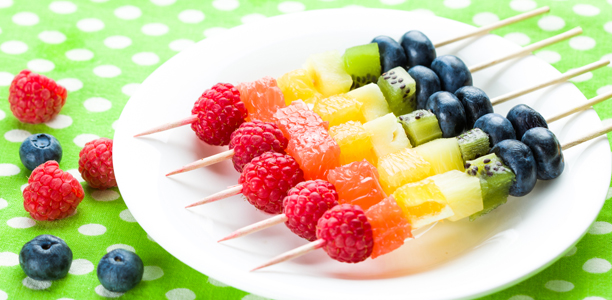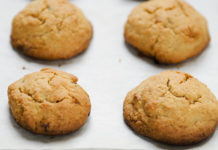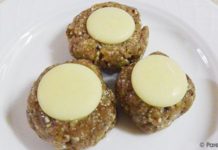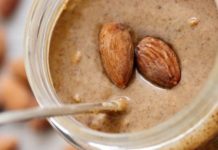A challenge that many parents face when preparing party food for their children is finding the right balance between healthy, tasty and fun food options. Rainbow skewers – made from different coloured fruit and/or vegetables – is an option that does just that.
Ingredients
There is no set recipe for making rainbow skewers. Instead, be guided by the colours.
We recommended basing quantities on the recommended daily fruit and vegetable intake for children (see below under nutritional information). A good starting guide is to make each skewer about one standard serving size.
Here is a table showing some examples of possible ingredients to make a rainbow fruit or vegetable skewer:
| Red | Orange / Yellow | Green | Purple / Blue | Brown / White |
| Strawberries Red grapes Watermelon Red apples Raspberries Cherries Tomato Red capsicum Radishes |
Mandarins Rockmelon Mangoes Oranges Peaches Nectarines Apricots Grapefruit Carrots Sweet potato Pumpkin Squash |
Green grapes Green apples Kiwifruit Asparagus Spinach Broccoli Celery Green capsicum Snow peas |
Purple grapes Blueberries Blackberries Plums Beetroot Purple carrots Purple asparagus Red cabbage |
Bananas Dates Brown pears White peaches Cauliflower Mushrooms Potatoes Parsnips Turnips |
Method
- Wash and chop fruit and vegetables into bite-sized pieces that can be skewered. (note: some vegetables should be cooked first).
- Skewer chopped pieces and arrange by colour
Tips
- You can mix and match ingredients depending on your preferences
- Squeeze lemon or orange juice over the skewers to stop the pieces of fruit or vegetables from turning brown (due to oxidisation). An alternative is to tightly cover the skewers with plastic wrap as soon as possible after they are made.
- You can make cheaper (and tastier) rainbow skewers by choosing fresh produce based on seasonal availability.
Nutritional information
‘Eat a rainbow’
Nutritionists categorise fruit and vegetables into five different colour categories: red, orange/yellow, green, white/brown and purple/blue. Each colour contains its own set of unique nutrients – called phytochemicals – that can help fight disease.
Red – Red fruits and vegetables contain lycopene, which is a powerful antioxidant that keeps our heart health and helps to reduce the risk of cancer.
Orange/yellow – Orange and yellow fruit and vegetables contain carotenoids. A well-known carotenoid is called betacarotene – this is converted to Vitamin A which helps maintain healthy mucous membranes (such as in our respiratory system and guts) and healthy eyes. Another carotenoid – lutein – is stored in the eye and has been found to reduce the risk of cataracts and other eye issues.
Green – Green fruit and vegetables also contain carotenoids, as well as indoles and saponins. These all have anti-cancer properties. Green leafy vegetables, such as spinach and broccoli, are great sources of folate.
Purple/blue – Purple and blue fruit and vegetables contain anthocyanin, which has antioxidant properties that can reduce the risk of cancer, stroke and heart disease.
Brown/white – Brown and white fruit and vegetables contain a range of health-promoting nutrients, such as allicin (found in garlic) which is known for its antiviral and antimicrobial properties. Some members of this group, such as bananas and potatoes, are also a fantastic source of potassium.
Recommended daily fruit and vegetable intake for children
The below table summarises the recommended daily fruit and vegetable intake for children 1-18 years of age:
| Age | Vegetables and legumes | Fruit |
| 1-2 years | 2-3 standard serves | 0.5 |
| 2-3 years | 2.5 | 1 |
| 4-8 years | 4.5 | 1.5 |
| 9-11 years | 5 | 2 |
| 12-18 years | Girls: 5 Boys: 5.5 |
2 |
For vegetables, a standard serve is about 75g. This is about:
- ½ cup of green or orange vegetables, such as broccoli or carrots
- 1 cup of green leafy or raw salad vegetables
- ½ cup sweet corn
- ½ medium sized potato
For fruits, a standard serve is about 150g. This is about:
- 1 medium apple, banana, orange or pear
- 2 small apricots, kiwi fruits or plums



 (4 votes, average: 4.00 out of 5)
(4 votes, average: 4.00 out of 5) 






